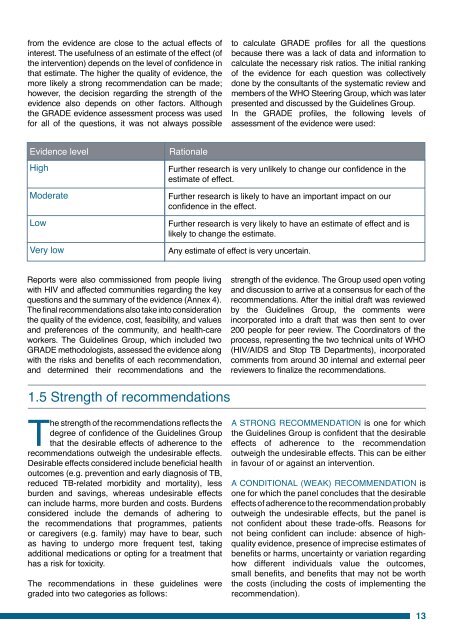Guidelines for intensified tuberculosis case-finding and isoniazid ...
Guidelines for intensified tuberculosis case-finding and isoniazid ...
Guidelines for intensified tuberculosis case-finding and isoniazid ...
Create successful ePaper yourself
Turn your PDF publications into a flip-book with our unique Google optimized e-Paper software.
from the evidence are close to the actual effects ofinterest. The usefulness of an estimate of the effect (ofthe intervention) depends on the level of confidence inthat estimate. The higher the quality of evidence, themore likely a strong recommendation can be made;however, the decision regarding the strength of theevidence also depends on other factors. Althoughthe GRADE evidence assessment process was used<strong>for</strong> all of the questions, it was not always possibleto calculate GRADE profiles <strong>for</strong> all the questionsbecause there was a lack of data <strong>and</strong> in<strong>for</strong>mation tocalculate the necessary risk ratios. The initial rankingof the evidence <strong>for</strong> each question was collectivelydone by the consultants of the systematic review <strong>and</strong>members of the WHO Steering Group, which was laterpresented <strong>and</strong> discussed by the <strong>Guidelines</strong> Group.In the GRADE profiles, the following levels ofassessment of the evidence were used:Evidence levelHighModerateLowVery lowRationaleFurther research is very unlikely to change our confidence in theestimate of effect.Further research is likely to have an important impact on ourconfidence in the effect.Further research is very likely to have an estimate of effect <strong>and</strong> islikely to change the estimate.Any estimate of effect is very uncertain.Reports were also commissioned from people livingwith HIV <strong>and</strong> affected communities regarding the keyquestions <strong>and</strong> the summary of the evidence (Annex 4).The final recommendations also take into considerationthe quality of the evidence, cost, feasibility, <strong>and</strong> values<strong>and</strong> preferences of the community, <strong>and</strong> health-careworkers. The <strong>Guidelines</strong> Group, which included twoGRADE methodologists, assessed the evidence alongwith the risks <strong>and</strong> benefits of each recommendation,<strong>and</strong> determined their recommendations <strong>and</strong> thestrength of the evidence. The Group used open voting<strong>and</strong> discussion to arrive at a consensus <strong>for</strong> each of therecommendations. After the initial draft was reviewedby the <strong>Guidelines</strong> Group, the comments wereincorporated into a draft that was then sent to over200 people <strong>for</strong> peer review. The Coordinators of theprocess, representing the two technical units of WHO(HIV/AIDS <strong>and</strong> Stop TB Departments), incorporatedcomments from around 30 internal <strong>and</strong> external peerreviewers to finalize the recommendations.1.5 Strength of recommendationsThe strength of the recommendations reflects thedegree of confidence of the <strong>Guidelines</strong> Groupthat the desirable effects of adherence to therecommendations outweigh the undesirable effects.Desirable effects considered include beneficial healthoutcomes (e.g. prevention <strong>and</strong> early diagnosis of TB,reduced TB-related morbidity <strong>and</strong> mortality), lessburden <strong>and</strong> savings, whereas undesirable effectscan include harms, more burden <strong>and</strong> costs. Burdensconsidered include the dem<strong>and</strong>s of adhering tothe recommendations that programmes, patientsor caregivers (e.g. family) may have to bear, suchas having to undergo more frequent test, takingadditional medications or opting <strong>for</strong> a treatment thathas a risk <strong>for</strong> toxicity.The recommendations in these guidelines weregraded into two categories as follows:A strong recommendation is one <strong>for</strong> whichthe <strong>Guidelines</strong> Group is confident that the desirableeffects of adherence to the recommendationoutweigh the undesirable effects. This can be eitherin favour of or against an intervention.A conditional (weak) recommendation isone <strong>for</strong> which the panel concludes that the desirableeffects of adherence to the recommendation probablyoutweigh the undesirable effects, but the panel isnot confident about these trade-offs. Reasons <strong>for</strong>not being confident can include: absence of highqualityevidence, presence of imprecise estimates ofbenefits or harms, uncertainty or variation regardinghow different individuals value the outcomes,small benefits, <strong>and</strong> benefits that may not be worththe costs (including the costs of implementing therecommendation).13















